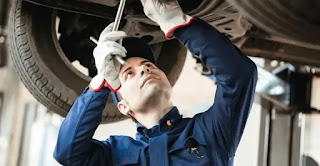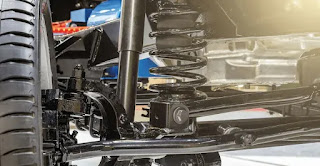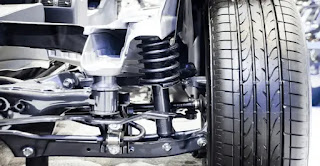Signs of damping problems and simple repairs you can do yourself
Have you suddenly noticed unusual noises after switching to summer tires, or do you have less control over the car's steering, or does it feel a little bouncy when you drive than it usually does? This is perfectly normal. Winter can affect the car's damping system, and it is much easier to notice strange noises when driving with summer tires than with the louder winter tires. Damping and steering are two crucial systems in a car and should not be ignored when they start to show signs of wear. Bad springs, shock absorbers or anti-roll bars will impair driving comfort and negatively affect driving characteristics and car safety. we recommends that you check the wheel damping early to avoid expensive repair costs and dangerous situations on the roads.
What is attenuation?
The damping system on a car is responsible for driving comfort by smoothing bumps in the road and providing grip by keeping the wheels on the ground as much as possible, which maximizes the car's overall performance. The damping system consists of springs, shock absorbers and rods / struts that connect them to joints / bearings / bushings, which allows certain components in the damping system to move in different directions. The interaction between springs and shock absorbers takes care of unevenness in the road conditions to increase comfort for passengers and drivers. When the car is running on a bump, the springs are compressed and store energy which is quickly released when the springs bounce back. If there were no shock absorbers on the car, it would "bounce" across the road, which is very inconvenient.
The damping is also important for the car's driving characteristics, such as the ability to safely accelerate, brake and turn. Among other things, it helps to stabilize the car in turns and when braking at the same time by using the springs that can complement each other.
Why should you check the damping of the wheels when spring comes?
Cold weather is miserable for your car. If the car's springs are made of metal that is not resistant to corrosion, they usually have a plastic coating. But when the springs are pressed together repeatedly, and also exposed to road salt, the plastic coating is damaged and the springs can start to rust.
If you skip washing under the car in the winter, the problems can get much worse.
The cold weather in winter also reduces tire pressure, which affects how the car drives. It can also have an effect on the function of the shock absorbers. Minus degrees and a lot of snow on the roads can significantly reduce the effectiveness of the shock absorbers. All these faults with the damping system can be hidden under the loud noise from the winter tires. When you change to summer tires, you can suddenly hear sounds that should not be there, and then it is a good idea to check the shock absorbers, springs and other parts of the car's damping system.
Signs that you should check the damping system
We often take the car's damping system for granted and do not care about it in the same way as the engine, gears and brake system. It is worth remembering that the damping carries the weight of the car, and if it does not work properly, you will not be able to steer the car as well in corners or when you brake. Therefore, it is very important that you pay attention to the early warning signs listed below:
Bumpy driving . If you start to feel every hole and bump in the road that is a sign that something is wrong with the wheel damping. This often indicates that the piston cylinder inside the shock absorber on the damping may be worn and therefore the entire shock absorber must be replaced. It also indicates that the springs or struts are not working optimally, so you should therefore check the entire damping carefully.
Unpleasant cornering . If you feel that the car is pulling in one direction in a curve, you should also check the damping. This means that the car's damping does not absorb the centrifugal forces that occur. When a car turns quickly, the body tilts. The weight is transferred to the wheels that are furthest in the direction of rotation, and the wheels' relationship to the ground is also affected. If you notice oversteer, ie that the car turns more than the steering wheel angle, or understeer, when the car makes a smaller change of direction than what the steering wheel angle and front wheel angle indicate, then it is a clear sign that the damping should be checked.
The car moves forward when you brake . If you notice that the car moves forward when you press the brake pedal, you should perform a comprehensive check of the wheel damping immediately. During emergency braking or to avoid a collision, this can have serious consequences as it affects the car's ability to stop quickly. When the vehicle tilts forward during braking, you will no longer be able to stop as efficiently. This condition can actually increase the car's downtime by as much as 20%.
Uneven tire wear . If you notice unevenly worn tires, it can be due to several things, including incorrect air pressure in the tires or incorrect wheel alignment or balancing, but it can also be a sign that you have problems with the damping. This may be an indication that the shock absorbers or struts are damaged and need to be replaced.
Leakage . If you see spills under the car or oil leakage from the damping system, it's time to visit the workshop. The most obvious cause of oil leakage is defective shock absorbers that need to be replaced. This is an expensive repair, but you can save yourself from other problems with the car and several thousand kroner if you carry out the repair early enough.
Vibration in the steering wheel when driving on uneven roads or unusual noises from the car's damping can also be a sign that you should inspect the shock absorbers, springs and other parts. The easiest way to find out if the springs work is to perform a bounce test. Park the car on a flat surface and push down the front of the car with your own body weight. Bounce the car three to four times both front and rear. If you feel that the car is shaking, even after you drop the weight, it is a sign that the damping is worn and needs to be replaced, or that the damaged parts need to be maintained.
Simple repairs you can do yourself
When you notice that the car has started to drive unevenly, most people assume that the entire damping is damaged and they quickly suspect that large and expensive parts such as springs, shock absorbers and the like need to be replaced. Before you visit the workshop and buy expensive parts, you can check the following:
Tighten nuts and bolts . You should pay special attention to mounting nuts and bolts as they are a direct part of the damping. If you find some that are loose, just tighten them again. If you are not comfortable doing this on your own, a car repair shop near you can do this quickly and cheaply for you.
Check the air pressure, tread depth and wheel alignment . If you feel that the car is pulling in one direction, it can be due to several things, such as:
- Low or uneven tire pressure, which is easy to fix at a gas station.
- Make sure that all your tires have been replaced recently and that you have the recommended tread depth on all tires. Also check that the wheel setting is correct with our simple guide.
Other things you should check out:
- The steering gear / rack may also need to be replaced or repaired.
- Inspect the brakes for uneven wear, overheating and other problems as this can also lead to steering problems.
Springs and shock absorbers
When the shock absorbers are worn, you notice that the car pumps and dives a little more than usual. Also check the springs and struts and see if they need to be repaired or replaced.
When replacing parts of the damping system, we suggest that you do it in pairs instead of just replacing the damaged side. This means that you get optimal performance from the car's damping. Buy only high quality parts . It prolongs life and can lead to large savings on repairs in the long run.
If you are unsure of your skills, you can always ask a workshop or authorized mechanic for help.
Read more:
1. How to perform a wheel alignment at home
2. How to test your alternator: TROUBLESHOOTING
3. Change the gearbox oil easily yourself – tips and instructions




0 Response to "Signs of damping problems and simple repairs you can do yourself"
Post a Comment